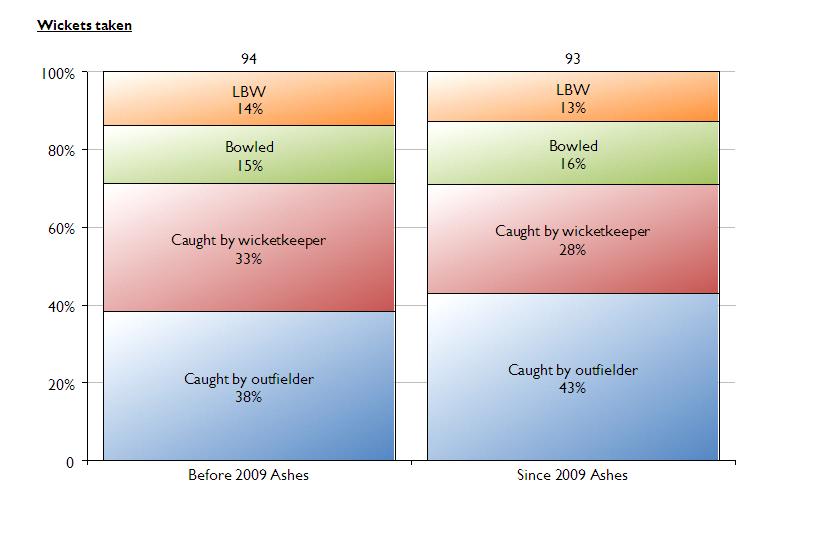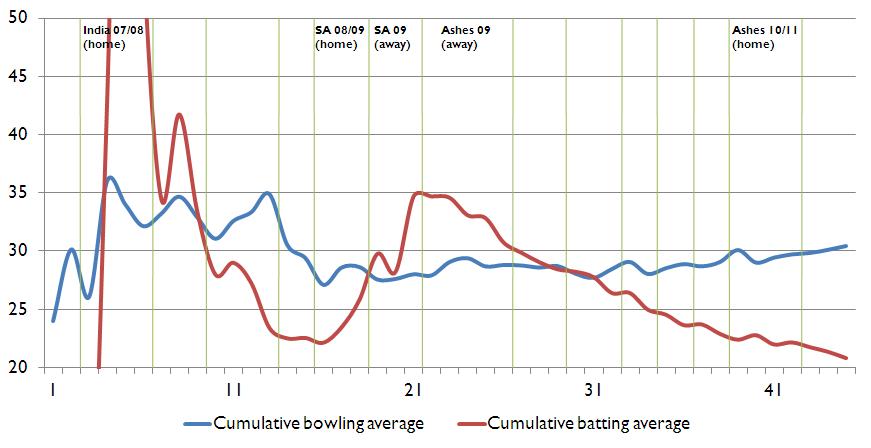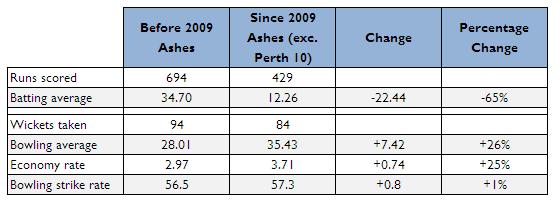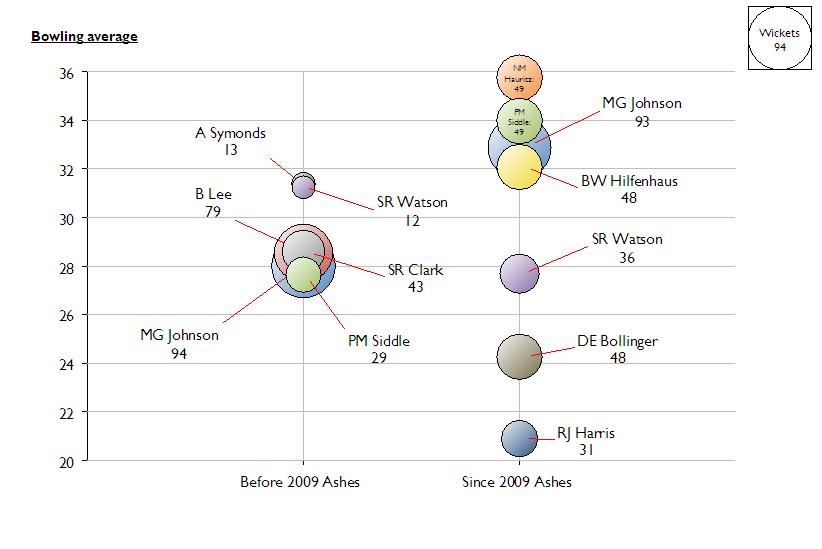
A gradual but inevitable descent into cricket-based loathing and bile.
The Two Halves Of Mitchell Johnson
Before we start
There are few things that divide the 51allout writers more than talking about Australia. Except for Craig Kieswetter. Or the ongoing debate about whether Informer by Snow is better than Ini Kamoze’s Here Comes The Hotstepper (it isn’t). After the humiliation of the Ashes series of the 90’s and early 00’s it can be something of a challenge to get a discussion going about the Aussies without it descending into childish name-calling. Luckily we’re in the Scorers’ Notes bit of the website so we can rely on some numbers to do the talking for us.
The main event
Today’s numbers are all about the man we might start calling the Aussie Harmison: Mitchell Guy Johnson. Recently axed from the Twenty20 side, and damned with faint praise from selectorial genius Andrew Hilditch, Johnson looks to be at the crossroads of his career.
Perhaps the most symbolic moment from the last Ashes series, and one that we need no excuse to watch again, is the sight of Mitchell Johnson hurling the ball miles down legside past Jonathan Trott and Brad Haddin, much to the delight of the Barmy Army. Here it is again on YouTube, about 30 seconds in:
The rest of those highlights aren’t too shabby either.
It may be fashionable to criticise Mitch these days but there’s no doubt that he’s been effective at various points in his Test career. His 187 wickets put him 14th on the all-time list for Australia, ahead of such luminaries as Geoff Lawson, Terry Alderman and Steve Smith. Plus his 1,186 runs put him comfortably in the top 82 Aussie batsmen, ahead of such luminaries as Usman Khawaja and Steve Smith.
Despite all these achievements, the feeling remains that Johnson has lost the spark that was so obvious through his initial career. Let’s have a look at his cumulative averages over his Test career, both with bat and ball.
We’ve split the different series with the vertical lines, and labelled a few significant ones – none more so than the 2009 Ashes. You can clearly see that his batting average, which was up around 35 before the series started, has never recovered and now hovers around the 20 mark, alongside the likes of Mark Lathwell. The increase in his bowling average is less drastic, but definitely visible as it creeps from 28.01 to a still reasonable 30.43.
In order to get a clearer view of what’s happened, we’ll just split his career in two, before that 2009 series and since:
And there we have some fairly drastic changes. A 62% decrease in his batting average, a 17% increase in his bowling average and a 24% increase in his economy rate. It’s hard to really argue against those numbers. It’s even more conclusive if you remove the effect of one standout performance in Perth last December (and having been there to witness it, we’ve done everything we can to forget it). If we exclude that performance from the second half of his career, it looks a little like this:
Pretty conclusive stuff. Even with our nerdiest glasses on we honestly can’t figure out the maths that kept him at number four in the Test bowling rankings for so long.
Another aspect that we wanted to look at was Johnson’s role in the Australian bowling attack. To do that, we’ve simply looked at the bowlers that have bowled with him during the two halves of his career (and taken ten or more wickets – sorry Steve Smith). And here we are:
A few things that jump out at us here. Firstly, lollipop charts are cool. Secondly, when was Peter Siddle actually good? And thirdly, how decent was that pre-2009 Ashes attack? Johnson (the big blue bubble), Lee, Siddle and Stuart Clark all took plenty of wickets at 28 or thereabouts (with Andrew Symonds and Shane Watson providing good support). Compare that to the right hand side, where only Watson, Bollinger and the very impressive but injury-riddled Ryan Harris are below 30.
The key thing is that Mitchell Johnson has the second best average on the left but the fifth best on the right. If we exclude the figures from Perth again he moves down to sixth (with Siddle moving up one place). It’s genuinely damning evidence – even with a revolving door of bowling partners (while he’s missed just one test since making his debut), Johnson has been anything but the main man for Australia.
One last thing for us to look at: there’s a perception that Johnson picks up his wickets while bowling dross. It’s a view that we subscribe to but it’s hard to get to this from the scorecards (and trawling through the commentaries for 45 Tests is a bit too much like work for our liking). Still, we did find one thing worth some further investigation. In terms of the two halves, Johnsons’s mix of dismissals is remarkably uniform: 67 of 94 wickets were caught in the first half, 66 of 93 in the second. But if we look at the breakdown of those catches, we get something like this:
 We can see that there’s a reasonable decrease in the percentage of catches by the wicketkeeper and an increase in the number by outfielders. A symptom of a man no longer doing the business outside off-stump? Or just an excuse to shoehorn another chart in? We’ll let you draw your own conclusions.
We can see that there’s a reasonable decrease in the percentage of catches by the wicketkeeper and an increase in the number by outfielders. A symptom of a man no longer doing the business outside off-stump? Or just an excuse to shoehorn another chart in? We’ll let you draw your own conclusions.
The evidence here is pretty conclusive. Ever since that 2009 Ashes series (and in particular the Lord’s test where England raced to 126/0 at lunch on the first day) Johnson has been Harmison-esque, doing just enough to keep his place in an attack that has been built to accommodate his flaws (no more so than the recent selection of Trent Copeland, brought in to do the ‘keeping control’ role that Mitch so clearly cannot do). It’s also fascinating to note that while Australia looked to pick the fastest bowlers they could find for the Ashes (Johnson/Harris/Siddle), it was England’s more patient, controlled approach (i.e. Messrs Tremlett and Bresnan) that saw the best results.
Epilogue
We don’t like finishing on such a serious point, so here’s a funny picture of some dogs:






1 Comment
Post a Comment
1
Bert
30 Sep 2011 14:16
I absolutely agree. You’ve hit the nail on the head in this article Nichael, thanks for confirming what I always thought. I’d even go so far as to say that Here Comes The Hotstepper was better than anything released by Bitty McLean, Red Dragon or CJ Lewis.
Oh, and good observations on Johnson as well.